How does Gen Z differ from Millennials, and why this is important for your strategy?
November 4, 2020
Posted By: Polihron Karapachov
Growing up means acquiring greater wealth, and responsibility. Over the past decade both Millennials and Generation Z have changed how business and brands think and operate and will continue to do so for decades to come. That’s why it’s worth taking time to understand some of the similarities and differences between today’s youngest consumer groups. Here we’ll show you what you need to know, and the implications for businesses in the travel and leisure space today.
Remember the mid-2010s when everything around us was pink? No? Cast your mind back to 2016 when Pantone announced Rose Quarts as the colour of 2016, the release of Grand Hotel Budapest, Drake’s “Hotline Bling” and many other events established ‘delicate pink’ as the colour of Millenials, or as it was eventually labelled “Millenial Pink”. However by 2018, when the oldest Gen Zers started graduating university and entering adulthood, contemporary media such as Vogue and Elle, were fast to establish Bright Yellow as the colour of the youth.
Why are we talking about colour charts? Because these colours - Millennial Pink and Bright Yellow- epitomize cuteness, warmth and vivacity, and also make people feel happier and more at ease. They also tap into a state of mind which, in a decade defined by multiple challenges, Zers and Millennials have been constantly searching for. Just as the differences between these colours represent important nuances between emotional states, here we’ll uncover the aspects that define and distinguish these two generations and reveal what brands need to address when engaging with each group.

Why micro generations and the nuances between them really do matter
In a period of rapid tech innovation and fast culture, the traditional way of adopting a 15-year generational span is increasingly redundant. After all, political attitudes and buying habits take just a few years to go out of fashion. Until recently ‘Xennials’ (younger Generation Xers, born 1976-1982) were the most commonly used example of a micro generation. However during the last few years the concept of ‘Zennials’ (1992-1998) has emerged, representing a group spanning the two generational groups, Millennials and Gen Zers. As you might expect, this group exhibits some of the behavioural traits of the generational group immediately above and below them:

Source: WGSN, WGSN: Zennials: The In-Between Generation, 2020
Very often, businesses focus simultaneously on Millennials and Gen Zers, however it’s important to perceive these small nuances and understand why it’s no longer feasible to adopt models focused on an entire generation, let alone strategies that address more than one generation as if they were all one homogenous group. As the life experience of the two generations has been shaped likewise by events such as the 2008 global financial crisis, globalisation, the rise of social media and smartphones, Millennials and Zers do share a lot of similarities however contextually there are some major differences:
Remember the mid-2010s when everything around us was pink? No? Cast your mind back to 2016 when Pantone announced Rose Quarts as the colour of 2016, the release of Grand Hotel Budapest, Drake’s “Hotline Bling” and many other events established ‘delicate pink’ as the colour of Millenials, or as it was eventually labelled “Millenial Pink”. However by 2018, when the oldest Gen Zers started graduating university and entering adulthood, contemporary media such as Vogue and Elle, were fast to establish Bright Yellow as the colour of the youth.
Why are we talking about colour charts? Because these colours - Millennial Pink and Bright Yellow- epitomize cuteness, warmth and vivacity, and also make people feel happier and more at ease. They also tap into a state of mind which, in a decade defined by multiple challenges, Zers and Millennials have been constantly searching for. Just as the differences between these colours represent important nuances between emotional states, here we’ll uncover the aspects that define and distinguish these two generations and reveal what brands need to address when engaging with each group.

Why micro generations and the nuances between them really do matter
In a period of rapid tech innovation and fast culture, the traditional way of adopting a 15-year generational span is increasingly redundant. After all, political attitudes and buying habits take just a few years to go out of fashion. Until recently ‘Xennials’ (younger Generation Xers, born 1976-1982) were the most commonly used example of a micro generation. However during the last few years the concept of ‘Zennials’ (1992-1998) has emerged, representing a group spanning the two generational groups, Millennials and Gen Zers. As you might expect, this group exhibits some of the behavioural traits of the generational group immediately above and below them:

Source: WGSN, WGSN: Zennials: The In-Between Generation, 2020
Very often, businesses focus simultaneously on Millennials and Gen Zers, however it’s important to perceive these small nuances and understand why it’s no longer feasible to adopt models focused on an entire generation, let alone strategies that address more than one generation as if they were all one homogenous group. As the life experience of the two generations has been shaped likewise by events such as the 2008 global financial crisis, globalisation, the rise of social media and smartphones, Millennials and Zers do share a lot of similarities however contextually there are some major differences:
- Millennials grew up in a progressive economic period pre-2008 (characterised by stable economic growth, falling unemployment, globalization and enlargement of the EU) while Gen Zers barely remember those times.
- Mobile phones became widespread for Millenials during their teenage years, while Zers are the first generation of kids to grow up with a smartphone.
- Millennials experienced social media before the era of “fake news” and as a means to reconnect with friends, while Zers adopted these platforms as fears of misinformation, trolling and privacy became more widespread. They also came of age at a time when influencers showing of their #bestlife were in their prime, and concerns about mental health were on the rise.
- Millennials were growing up as the Berlin Wall came down, the European Union was enlarged and borders opened. Gen Zers grew up with borderless travel as something natural, while at the same time experiencing growing fears about migration and of course, the reintroduction of border controls related to COVID-19.
How are the generations divided by the major themes of our age?
Let’s take a look at some of the major themes that young people have identified through various studies, as the issues that are of most important to them, as well as some of the major socio-economic challenges of our age. We’ll dive in to take a look at how these issues play out between the two generations.
Generations defined by anxiety
Looking again at that ‘Millennial Pink’ and ‘Bright Yellow’, it’s not by chance that these two generations who are largely defined by anxiety,are triggered by these two colours. As stated in our previous blog post, Generation Z has been labelled by researchers as the most anxious generation to date, however, until recent years, their slightly older counterparts have also been labelled as the “most anxious generation in history”.
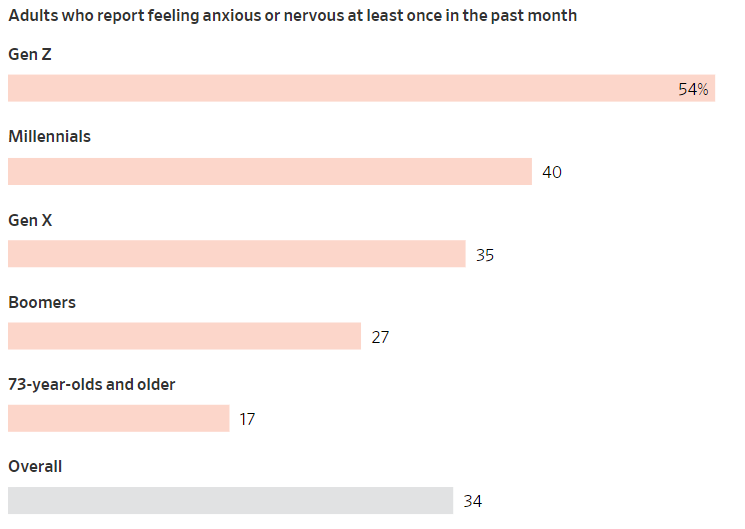
Source: Wall Street Journal, 2019
Government and social activism
While Millennials were entering adulthood, during the previous decade, they experienced the unravelling of the climate crisis, the war in Syria and the subsequent refugee crisis, the Global Financial Crisis and the development of movements like Occupy, Black Lives Matter and Me Too. Gen Zers experienced those same events as children and teenagers during their transformative years and while Millenials had largely grown up during a prosperous pre-2008 time, their younger counterparts never experienced that, a situation now clearly compounded by the coronavirus crisis and a massive global recession.
Issues such as increased climate awareness could explain Gen Z’s stronger incline to social activism, as indicated in our last blog post. However, their “companions” in this fight for a change remain Millennials, as it could be seen from the graphs below. For example, in Germany and the U.S. young people’s expectations with regards to the government’s responsibility for solving global challenges, compared to previous generations have significantly increased.
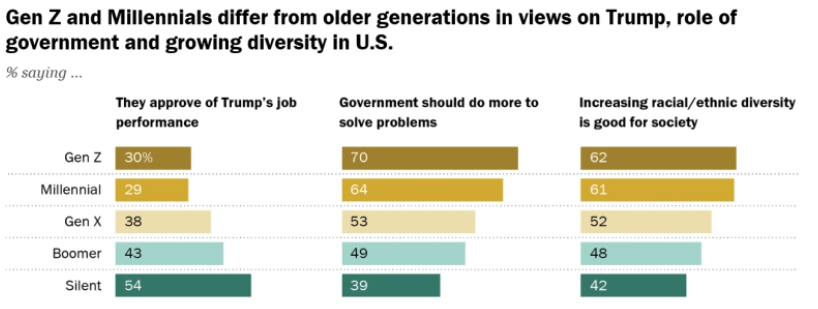 Source: Pew Research Studies, 2019
Source: Pew Research Studies, 2019
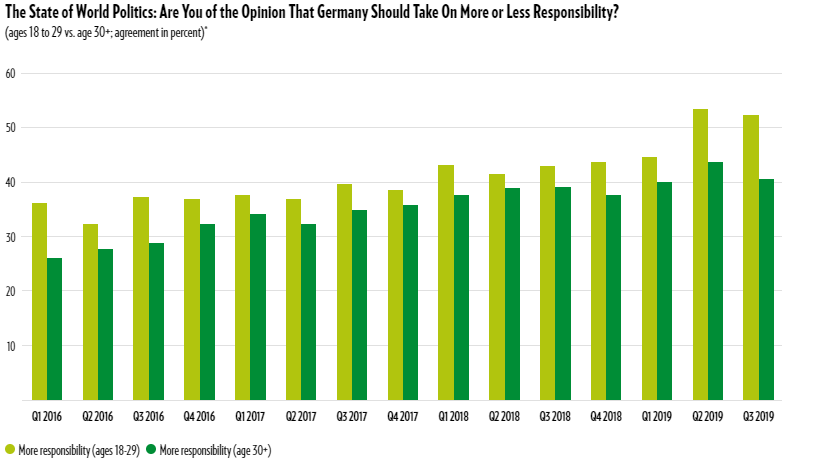
Source: Global Public Policy Institute, 2020
Peer-to-peer influence
A dynamic which has already started with Millenials and which helped to propel the sharing economy in its early years has also proven to be very relevant also for Gen Zers. In times of “fake news” and “greenwashing”, young people are craving authenticity and prefer to trust people close to them when making decisions about their life, and indeed, their purchases. As a result family, friends or celebrities have a higher influence on the purchasing decision of younger generations, meaning that they are essentially rejecting heavily branded content and favouring authentic and unedited images.
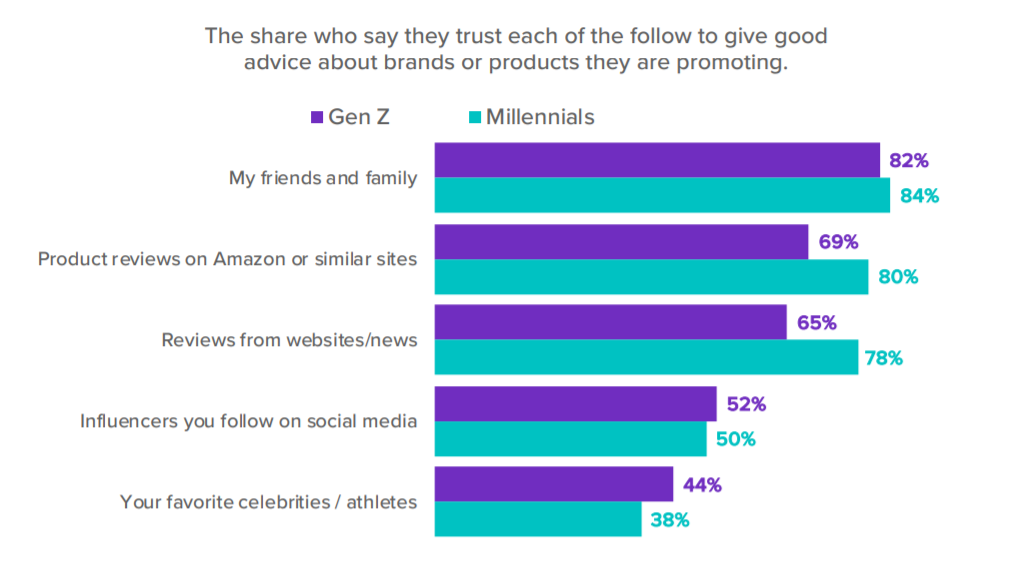
Source: Morning Consult, 2019
However despite these similarities, it is also important to understand what makes them different from each other. How does their social media behaviour compare? What is the difference in attitudes concerning climate change? Below we will outline some of the important contrasts between Millennials and Zers in terms of social media, brand loyalty and sustainability.
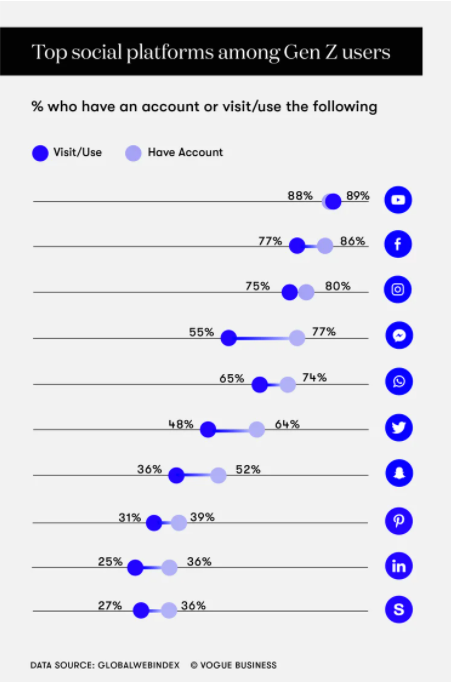
Social media: Sharing real-life experiences vs Dark Social
Taking into consideration that Millenials are the generation that fully embraced the experience economy (with 72% preferring to spend on experiences rather on material things), it is not by chance that Millennials have perceived social media as the main platform to share their experiences. Phrases like “pics or it didn’t happen” or terms such as “FOMO” came to define this generation, as they prefer to present a highly curated and idealised version of their life by sharing their experiences on social media channels. A great example in this context is RedBull and their experiential marketing, where the values of the brand are promoted largely through events and experiences such as the live stream of the Red Bull Stratos jump, Red Bull TV or esports.
Brand loyalty vs personalisation
To uncover the differences between the two groups we also need to understand the consumer culture context in which they have each grown up. If Millennials grew up in a very binary world (e.g. Coca Cola vs Pepsi, Marvel vs DC, PlayStation vs XBOX), living in an environment of abundance and choice, in the case of Zers, has led to a different perception of brands. Due to their context, Millennials relate themselves easily to brands and businesses, and as a result they seem to be quite loyal, with 50% stating that they are loyal or quite loyal to their brands. On the other hand personalisation plays a crucial role for Generation Z. According to a recent survey by WP Engine, 75% of Gen Zers are more likely to buy a product if they can customise it themselves, while 41% are open to giving up data privacy concerns if they receive a personalised experience in return. In fact, in some cases, this is resembling more of a “individualisation” dynamic, where consumers themselves customise their own experiences. For example in a survey from 2019 on the consumption of Bundesliga matches in Germany, it was observed that Zers are the generation that prefers match summaries tailored to individual interests, for example, highlighting a focus on players of a certain nationality or on goalkeeper saves rather than a generic match summary.

Source: Future Study Bundesliga Consumption, 2019
Diverging attitudes about sustainability
It could be easily stated that Millennials and Generation Z are the two most sustainable-conscious generations that the world has ever seen and that as a result, brands and businesses have started addressing that component during the last 10 years. Nonetheless, there are some important differences. As Millenials are more likely to identify with brands, they often look to those brands for solutions and best practices. However on many occasions these demands were addressed only in the form of marketing campaigns without any substance. Subsequently, terms such as ‘greenwashing’ emerged, with companies such as H&M and Volkswagen coming under attack.
As a more socially active generation, Generation Z has called out businesses and brands, demanding more transparency in their actions, seeking truly innovative actions that go beyond mere marketing. They go one step further than Millennials, addressing wider issues such as equality and mental health, among others. Following these dynamics, brands like Patagonia have decided to donate $10 million saved from tax cuts to environmental groups, while another popular and respected brand among Zers, Nike, has been endorsing the Black Lives Matter movement since its early days.
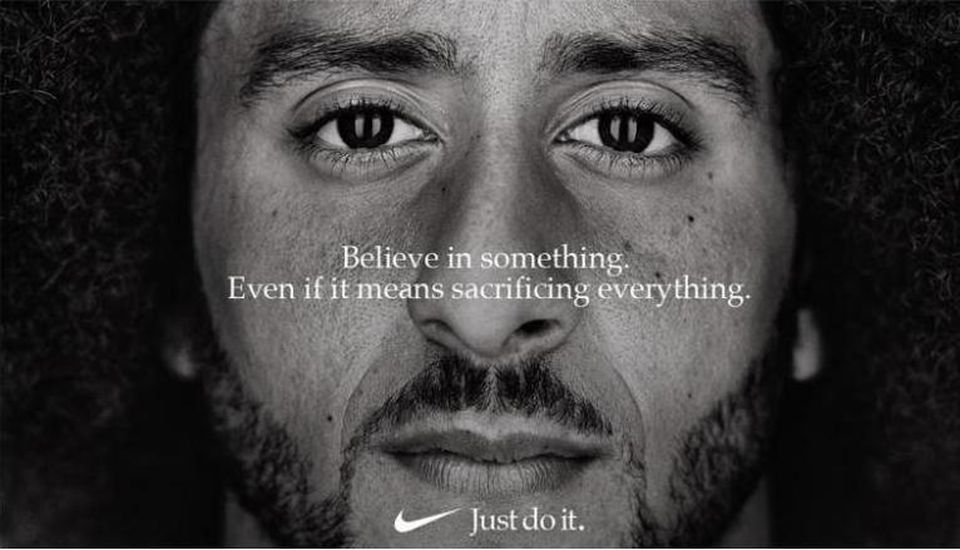
Why generational studies matters for your destination and how we can help you build your strategy
As the future lays in these two similar generations, it is indispensable for companies to understand what motivates them but also to know what the small but important differences are between them.
For the past decade, all of us at TOPOSOPHY have been following the characteristics of young generations closely, and giving practical advice to all our clients by:
Let’s take a look at some of the major themes that young people have identified through various studies, as the issues that are of most important to them, as well as some of the major socio-economic challenges of our age. We’ll dive in to take a look at how these issues play out between the two generations.
Generations defined by anxiety
Looking again at that ‘Millennial Pink’ and ‘Bright Yellow’, it’s not by chance that these two generations who are largely defined by anxiety,are triggered by these two colours. As stated in our previous blog post, Generation Z has been labelled by researchers as the most anxious generation to date, however, until recent years, their slightly older counterparts have also been labelled as the “most anxious generation in history”.

Source: Wall Street Journal, 2019
Government and social activism
While Millennials were entering adulthood, during the previous decade, they experienced the unravelling of the climate crisis, the war in Syria and the subsequent refugee crisis, the Global Financial Crisis and the development of movements like Occupy, Black Lives Matter and Me Too. Gen Zers experienced those same events as children and teenagers during their transformative years and while Millenials had largely grown up during a prosperous pre-2008 time, their younger counterparts never experienced that, a situation now clearly compounded by the coronavirus crisis and a massive global recession.
Issues such as increased climate awareness could explain Gen Z’s stronger incline to social activism, as indicated in our last blog post. However, their “companions” in this fight for a change remain Millennials, as it could be seen from the graphs below. For example, in Germany and the U.S. young people’s expectations with regards to the government’s responsibility for solving global challenges, compared to previous generations have significantly increased.
 Source: Pew Research Studies, 2019
Source: Pew Research Studies, 2019
Source: Global Public Policy Institute, 2020
Peer-to-peer influence
A dynamic which has already started with Millenials and which helped to propel the sharing economy in its early years has also proven to be very relevant also for Gen Zers. In times of “fake news” and “greenwashing”, young people are craving authenticity and prefer to trust people close to them when making decisions about their life, and indeed, their purchases. As a result family, friends or celebrities have a higher influence on the purchasing decision of younger generations, meaning that they are essentially rejecting heavily branded content and favouring authentic and unedited images.

Source: Morning Consult, 2019
However despite these similarities, it is also important to understand what makes them different from each other. How does their social media behaviour compare? What is the difference in attitudes concerning climate change? Below we will outline some of the important contrasts between Millennials and Zers in terms of social media, brand loyalty and sustainability.

Social media: Sharing real-life experiences vs Dark Social
Taking into consideration that Millenials are the generation that fully embraced the experience economy (with 72% preferring to spend on experiences rather on material things), it is not by chance that Millennials have perceived social media as the main platform to share their experiences. Phrases like “pics or it didn’t happen” or terms such as “FOMO” came to define this generation, as they prefer to present a highly curated and idealised version of their life by sharing their experiences on social media channels. A great example in this context is RedBull and their experiential marketing, where the values of the brand are promoted largely through events and experiences such as the live stream of the Red Bull Stratos jump, Red Bull TV or esports.
However in the case of Gen Zers, due to concerns about data security and their preference for more curated networks and niche ecosystems, they appear to be moving to more private platforms to share content. As a result, the term “Dark social” has entered contemporary culture. Gen Zers prefer to share content via private messaging, making it more difficult for brands to trace their activity. Partly to address this, Playstation. together with Livity created branded GIFs as a method to engage more effectively with younger people.
Brand loyalty vs personalisation
To uncover the differences between the two groups we also need to understand the consumer culture context in which they have each grown up. If Millennials grew up in a very binary world (e.g. Coca Cola vs Pepsi, Marvel vs DC, PlayStation vs XBOX), living in an environment of abundance and choice, in the case of Zers, has led to a different perception of brands. Due to their context, Millennials relate themselves easily to brands and businesses, and as a result they seem to be quite loyal, with 50% stating that they are loyal or quite loyal to their brands. On the other hand personalisation plays a crucial role for Generation Z. According to a recent survey by WP Engine, 75% of Gen Zers are more likely to buy a product if they can customise it themselves, while 41% are open to giving up data privacy concerns if they receive a personalised experience in return. In fact, in some cases, this is resembling more of a “individualisation” dynamic, where consumers themselves customise their own experiences. For example in a survey from 2019 on the consumption of Bundesliga matches in Germany, it was observed that Zers are the generation that prefers match summaries tailored to individual interests, for example, highlighting a focus on players of a certain nationality or on goalkeeper saves rather than a generic match summary.

Source: Future Study Bundesliga Consumption, 2019
Diverging attitudes about sustainability
It could be easily stated that Millennials and Generation Z are the two most sustainable-conscious generations that the world has ever seen and that as a result, brands and businesses have started addressing that component during the last 10 years. Nonetheless, there are some important differences. As Millenials are more likely to identify with brands, they often look to those brands for solutions and best practices. However on many occasions these demands were addressed only in the form of marketing campaigns without any substance. Subsequently, terms such as ‘greenwashing’ emerged, with companies such as H&M and Volkswagen coming under attack.
As a more socially active generation, Generation Z has called out businesses and brands, demanding more transparency in their actions, seeking truly innovative actions that go beyond mere marketing. They go one step further than Millennials, addressing wider issues such as equality and mental health, among others. Following these dynamics, brands like Patagonia have decided to donate $10 million saved from tax cuts to environmental groups, while another popular and respected brand among Zers, Nike, has been endorsing the Black Lives Matter movement since its early days.

Why generational studies matters for your destination and how we can help you build your strategy
As the future lays in these two similar generations, it is indispensable for companies to understand what motivates them but also to know what the small but important differences are between them.
For the past decade, all of us at TOPOSOPHY have been following the characteristics of young generations closely, and giving practical advice to all our clients by:
- Providing practical guides for destination authorities.
- Consumer research on attitudes towards trip planning and city visits.
- Developing brand image perception studies, behaviour analytics and psychographic models such as visitor profiling & persona development.
- Delivering practical policy recommendations on designing products and services.
- Supporting product development through action-oriented design sprints.
Considering the profound changes that businesses and brands have endured during the last 10 years, it is clear that the following decade will be even more transformational. We, at TOPOSOPHY, will be here to guide you through it.
Who We Are:
We have been global thought leaders in destination development, management and marketing for the last 10 years. We transform places and destinations through the skills and international experience of 12 members of staff and a global network of 20+ experts. In total, we have undertaken projects and offered integrated solutions to trusted clients in 20+ countries across 4 continents. We’re ready to support you too.
Contact us
If you’d like to know more about what we’ve presented here, you’re always welcome to get in contact with us. Just drop us a line at info@toposophy.com or send us a note through our contact page.
Who We Are:
We have been global thought leaders in destination development, management and marketing for the last 10 years. We transform places and destinations through the skills and international experience of 12 members of staff and a global network of 20+ experts. In total, we have undertaken projects and offered integrated solutions to trusted clients in 20+ countries across 4 continents. We’re ready to support you too.
Contact us
If you’d like to know more about what we’ve presented here, you’re always welcome to get in contact with us. Just drop us a line at info@toposophy.com or send us a note through our contact page.

COMMENTS